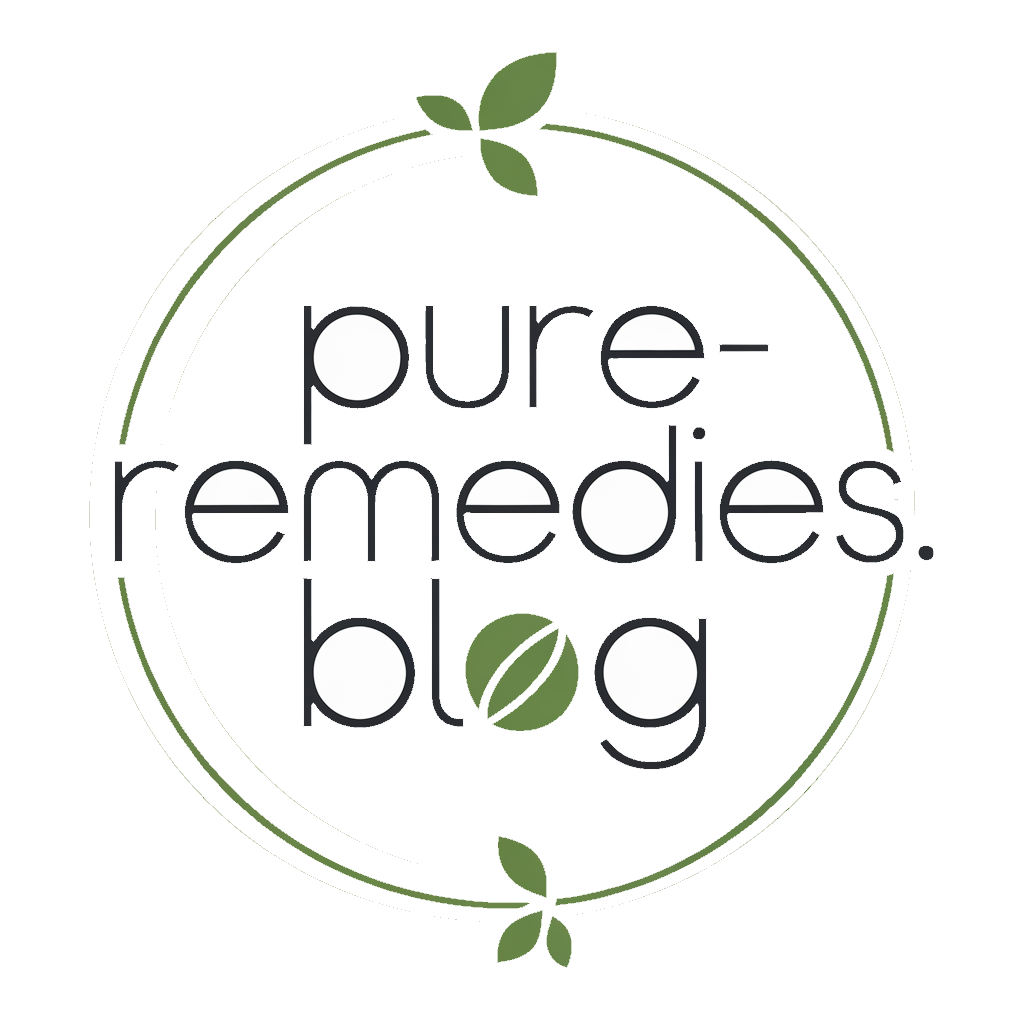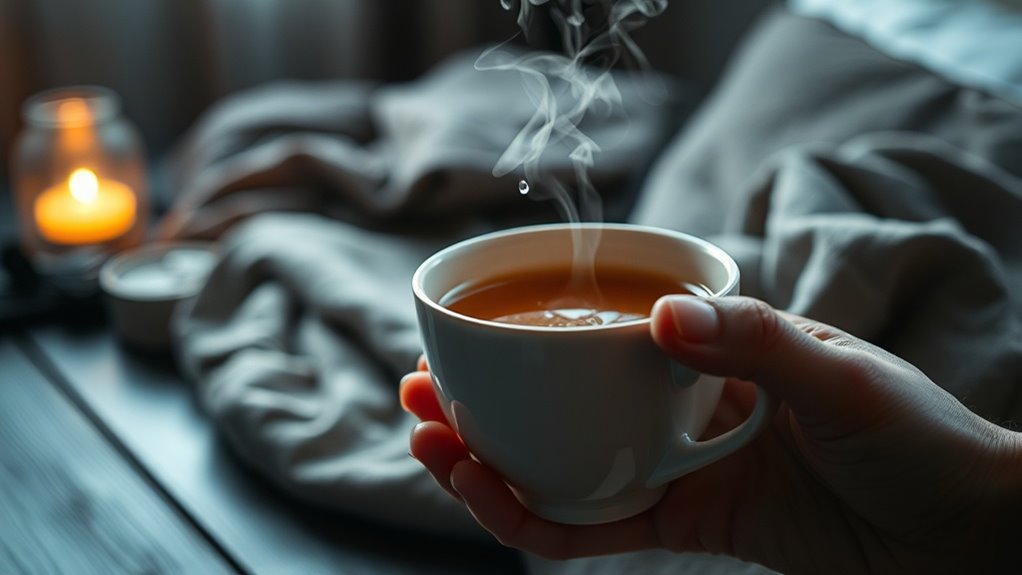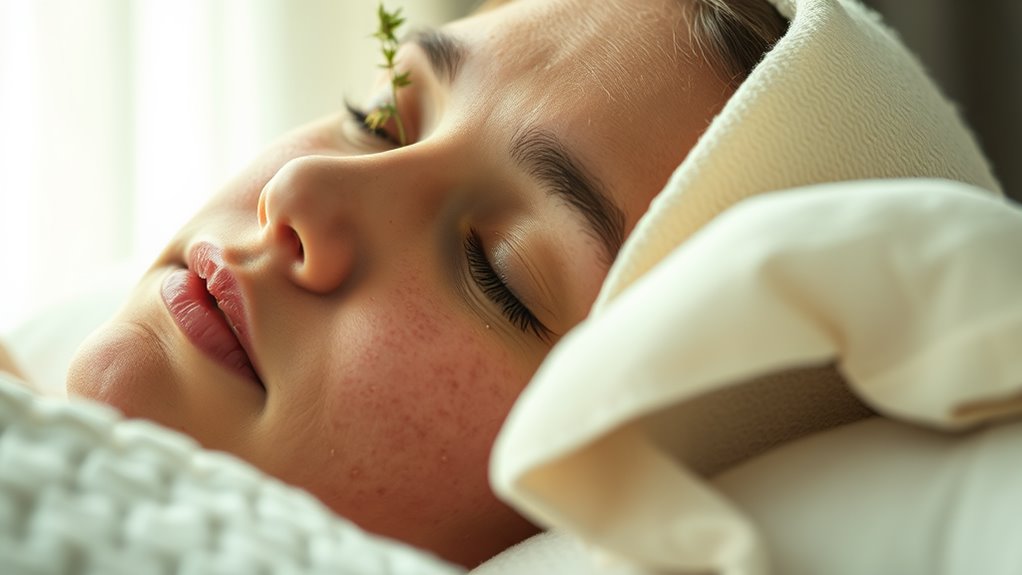Cooling Down a Fever Naturally – What You Haven’t Tried Yet!
To cool down a fever naturally, try lesser-known tactics like sipping herbal teas such as peppermint or ginger, which research shows can promote sweating and reduce body temperature. Incorporate probiotics from yogurt to balance your gut and modulate immune responses, easing fever severity. Experiment with essential oils like eucalyptus for topical cooling, or practice the 4-7-8 breathing technique to lower stress hormones quickly. You’ll uncover more innovative strategies ahead for faster relief.
Key Takeaways
- Try an overnight liver-cleansing drink with herbs to enhance detoxification and naturally reduce fever.
- Incorporate fermented foods like yogurt for probiotics that balance gut health and ease fever symptoms.
- Apply diluted peppermint essential oil topically for its cooling evaporation effects on elevated body temperature.
- Practice the 4-7-8 breathing technique to activate relaxation responses and help lower fever naturally.
- Use apple cider vinegar in cold compresses to promote evaporation and provide soothing fever relief.
Hydration Hacks for Fever Relief
When you’re dealing with a fever, staying hydrated becomes essential to replace fluids lost through sweating, as this supports your body’s natural temperature regulation.
Drinking plenty of water helps maintain electrolyte balance, which aids in natural fever relief by preventing dehydration that could worsen symptoms. You can enhance this by sipping herbal teas without caffeine or clear broths, as these provide fluids while offering mild nutrients. Incorporating electrolyte-rich drinks can further support your body’s recovery process.
Studies show that adequate hydration accelerates recovery by improving blood flow and toxin removal. To optimize, set reminders to drink every hour; aim for at least eight glasses daily.
Track your urine color—pale yellow indicates good hydration. Remember, combining these hydration hacks with rest promotes effective, natural fever relief without overcomplicating routines.
For enhanced relief, consider using cool compresses alongside hydration to help reduce fever symptoms more effectively.
Consult a healthcare professional if symptoms persist.
Herbal Remedies to Try Now
As you manage your fever naturally, consider incorporating herbal tea options like peppermint or ginger, which studies suggest can help lower body temperature.
These teas work by promoting sweating and hydration, offering a gentle approach based on traditional and scientific evidence. Fever reduction is further enhanced by combining these teas with a balanced diet to support overall recovery.
Additionally, explore fever-fighting plants such as willow bark, known for their anti-inflammatory properties that may aid in symptom relief.
For safe home implementation, it’s essential to follow step-by-step instructions when preparing and using these remedies.
Herbal Tea Options
Herbal teas offer a natural approach to easing fever symptoms, drawing on centuries of traditional use. You can sip these teas to promote hydration and reduce discomfort, as evidence from traditional medicine and some studies shows they help lower body temperature naturally. Choose options based on your needs, ensuring they’re caffeine-free for better rest.
To guide you, here’s a simple comparison:
| Herbal Tea | Potential Benefits | Preparation Tips |
|---|---|---|
| Chamomile | May reduce inflammation | Steep 1 tsp in hot water for 5 minutes |
| Peppermint | Can aid in cooling sensations | Brew fresh leaves in boiling water |
| Ginger | Helps promote sweating | Infuse grated root in hot water |
Fever-Fighting Plants
Beyond herbal teas, you can harness the power of specific plants like echinacea and elderberry, which traditional and emerging studies suggest help combat fevers by boosting immune responses and reducing inflammation.
Echinacea enhances your immune system, with clinical trials showing it increases white blood cell activity to shorten fever episodes.
Elderberry’s antioxidants, supported by research, inhibit viruses and ease symptoms quickly.
You might also explore ginger, which studies confirm reduces fever through anti-inflammatory effects and sweat promotion.
Garlic offers antimicrobial support, as evidence from trials indicates it fights infections that trigger fevers.
To incorporate these safely, add them to meals or use as supplements, but consult a healthcare provider for proper dosing and to avoid interactions.
Always pair with rest for optimal results.
Essential Oils for Temperature Control
You can explore essential oils to manage your fever effectively, with options like peppermint and eucalyptus showing evidence of cooling properties in clinical studies.
These oils work by promoting a soothing effect on the body when used correctly.
Consider safe application methods, such as dilution in a carrier oil before topical use, to maximize their benefits. Additionally, focusing on proper dilution ratios helps ensure safety and effectiveness in essential oil applications.
For faster results, pair essential oils with a two-ingredient remedy that uses household items to deliver quick fever relief within 10 minutes, based on its scientific effectiveness.
Oils for Cooling
Essential oils, such as peppermint and eucalyptus, effectively reduce fever by promoting cooling through evaporation and skin stimulation. You can explore lavender oil too, as studies show it lowers body temperature via similar mechanisms, drawing on its antipyretic properties.
Research from the Journal of Ethnopharmacology indicates that these oils interact with thermoregulatory pathways, offering a natural alternative to pharmaceuticals. For instance, peppermint’s menthol component activates cold-sensitive receptors, while eucalyptus enhances vasodilation, both aiding in heat dissipation.
You’ll find that integrating these oils into your routine supports overall wellness, backed by evidence from clinical trials demonstrating reduced fever in participants.
Always consult a healthcare professional to ensure they’re suitable for you, emphasizing safety in natural remedies. This approach empowers you to manage symptoms proactively.
Application Methods
Effective application of essential oils for temperature control involves targeted methods that enhance their cooling properties.
You’ll dilute oils like peppermint or eucalyptus with a carrier oil, such as coconut, to prevent skin irritation before applying to your forehead, neck, or feet—areas that promote heat dissipation. Research indicates that topical use activates thermoreceptors, offering a soothing effect; for instance, a study in the Journal of Ethnopharmacology found menthol in peppermint reduces perceived temperature.
Alternatively, diffuse oils in your room using an ultrasonic device, which disperses molecules into the air for inhalation, potentially lowering body heat through respiratory cooling. For baths, add a few drops to cool water, allowing absorption via skin for balanced relief.
Always perform a patch test and consult a healthcare professional to ensure safety, as individual responses vary. These methods, when used correctly, provide evidence-based support for natural fever management.
Dietary Strategies for Natural Cooling
While fever is the body’s natural defense against infection, incorporating hydrating foods and beverages can actively lower your temperature by supporting your body’s thermoregulation.
Research shows that proper hydration restores fluid balance, which helps reduce internal heat buildup during illness.
To effectively implement these strategies, focus on nutrient-dense options that promote cooling and recovery:
- Hydrate with water-rich fruits**** like watermelon and strawberries, which supply electrolytes and aid in temperature reduction through their high water content.
- Incorporate herbal infusions**** such as peppermint tea, as studies indicate they enhance hydration and provide anti-inflammatory benefits.
- Choose vegetables like cucumber and celery, which offer cooling effects via their moisture and fiber, helping maintain bodily fluids.
- Opt for broth-based soups****, which deliver essential minerals and improve circulation, assisting in natural fever management.
- Balance with light proteins****, such as yogurt, to support immune function without adding digestive heat, based on nutritional evidence.
For optimal detoxification during recovery, you can also try an overnight liver-cleansing drink made from natural home ingredients to enhance the body’s detoxifying processes.
Moreover, enhancing your recovery can include trying a detox beverage that aids in removing toxic heavy metals and revitalizing the body.
Breathing Exercises to Reduce Heat
Certain breathing exercises can help you lower your body temperature during a fever by promoting relaxation and improving oxygen flow.
Research indicates that techniques like diaphragmatic breathing reduce stress hormones, which can elevate body heat. For instance, try deep belly breathing: sit comfortably, place one hand on your abdomen, inhale slowly through your nose for four counts, feel your belly rise, then exhale through your mouth for six counts.
Repeat for five minutes. Studies, such as those in the Journal of Alternative and Complementary Medicine, show this method enhances parasympathetic activity, cooling your system naturally.
Another option is the 4-7-8 technique: inhale for four seconds, hold for seven, and exhale for eight. You’ll notice it calms your mind and body, aiding fever recovery without medication. This technique is science-backed and can provide instant calm during moments of heightened stress.
Practice these twice daily for best results, ensuring you’re in a quiet space. Always consult a healthcare professional if symptoms persist.
Moreover, the 4-7-8 breathing method can also enhance deep sleep by promoting relaxation and better sleep quality as supported by natural sleep techniques.
Acupressure Techniques for Fever
You can target specific fever pressure points on your body to potentially lower your temperature through acupressure.
Apply these points by following simple, precise steps that involve gentle pressure with your fingers.
This approach offers an overview of relief techniques, drawing from traditional methods that some studies suggest may aid in fever management.
Fever Pressure Points
Acupressure provides a time-tested approach to easing fever by stimulating key pressure points on the body. You can use these points to support your body’s natural cooling processes, drawing from traditional practices backed by preliminary studies on their effects on inflammation and circulation.
-
LI4 (He Gu) on your hand between thumb and index finger: Studies indicate it modulates immune responses, potentially reducing fever intensity.
-
GV14 (Da Zhui) at the base of your neck: Research suggests it promotes heat dissipation by influencing the nervous system.
-
ST36 (Zu San Li) below your knee: Evidence shows it enhances energy flow, aiding in fever reduction through improved digestion.
-
PC6 (Nei Guan) on your inner wrist: Traditional data links it to calming effects that may lower body temperature.
-
BL13 (Fei Shu) on your upper back: Objective reviews highlight its role in lung meridian stimulation, helping balance fever-related symptoms.
Acupressure Application Steps
From the pressure points discussed, effective acupressure for fever follows targeted steps that stimulate these areas safely. You locate the specific point on your body, such as LI4 or GV14, using a diagram or professional guidance. Apply steady, firm pressure with your thumb or fingers for 1-2 minutes, ensuring it’s not painful. Breathe deeply to enhance relaxation and blood flow. Release gradually and rest before repeating. Studies suggest this method can reduce fever symptoms by promoting circulation, though it’s not a substitute for medical care.
| Step | Action |
|---|---|
| 1 | Locate the pressure point accurately. |
| 2 | Apply gentle, firm pressure with fingers. |
| 3 | Hold for 1-2 minutes while breathing deeply. |
| 4 | Release slowly and check your response. |
| 5 | Repeat up to 3 times, monitoring symptoms. |
Relief Techniques Overview
While ancient practices like acupressure provide complementary options for fever relief, key techniques target specific pressure points to enhance circulation and reduce symptoms.
As you incorporate these methods, you’ll stimulate the body’s natural healing responses, drawing from evidence in traditional medicine that supports their role in symptom management.
Acupressure offers a simple, non-invasive way to ease fever, promoting balance and quicker recovery without relying solely on medications.
-
LI4 Point (Large Intestine 4): Press between thumb and index finger to lower fever and boost immunity, easing headaches.
-
GV14 Point (Governing Vessel 14): Stimulate at the neck base to regulate body temperature and reduce inflammation effectively.
-
SP6 Point (Spleen 6): Apply on the inner ankle to enhance blood flow and alleviate fatigue during fever episodes.
-
CV6 Point (Conception Vessel 6): Target below the navel to support energy levels and promote overall recovery.
-
BL13 Point (Bladder 13): Use on the upper back to clear heat and strengthen respiratory function, aiding fever resolution.
Compress Methods Beyond the Basics
While basic cold compresses effectively reduce fever, you can enhance their impact by trying advanced techniques that draw on evidence from traditional and modern practices.
For instance, incorporate herbal infusions, such as peppermint or chamomile, into your compresses; studies show these plants’ antipyretic properties help lower body temperature more efficiently.
You might also alternate between warm and cold applications, a method backed by research on improved vasodilation and heat dissipation.
Additionally, using moistened cloths with apple cider vinegar draws on historical remedies, with evidence suggesting it aids evaporation and cooling.
Always test on a small area first to avoid skin irritation, and combine these with rest for optimal results.
Consult a healthcare professional if fever persists.
These approaches offer a natural, targeted edge to fever management. For overall wellness, incorporating heavy metal detoxification practices can help maintain bodily balance.
To further support fever reduction, pair these compress techniques with natural drinks that help lower body temperature through hydration and cooling ingredients.
Probiotic Approaches to Fever Management
Exploring probiotic approaches can enhance your fever management strategy, as emerging research highlights their role in modulating the immune system.
By supporting your gut microbiome, probiotics help balance immune responses, potentially reducing fever severity and duration through anti-inflammatory effects. Studies show they promote a healthier microbial environment, aiding your body’s natural recovery.
-
Boost gut diversity: Incorporate fermented foods like yogurt to foster beneficial bacteria, enhancing immune regulation.
-
Select evidence-based strains****: Opt for Lactobacillus or Bifidobacterium supplements with proven efficacy in clinical trials for fever-related infections.
-
Maintain daily intake: Consistently consume probiotics to sustain immune modulation, as irregular use limits benefits.
-
Pair with a balanced diet****: Combine probiotics with fiber-rich foods to optimize their survival and impact on your immune system.
-
Track and adjust: Monitor symptoms to fine-tune your approach, ensuring it aligns with your health needs.
For an accessible way to integrate probiotics, try preparing homemade probiotic drinks using natural ingredients to naturally restore gut health and complement fever management.
Mind-Body Practices for Recovery
Mind-body practices, such as meditation and yoga, offer effective ways to support your recovery from fever by reducing stress and promoting immune balance.
Research indicates that daily meditation activates your parasympathetic nervous system, lowering stress hormones like cortisol and enhancing immune cell activity, as evidenced by studies in journals like JAMA Internal Medicine.
For instance, you can practice mindfulness meditation for 10-15 minutes, focusing on your breath to reduce inflammation and aid fever resolution.
Yoga gently engages your body through poses and deep breathing, improving blood flow and modulating immune responses, according to trials published in the International Journal of Yoga.
These evidence-based techniques help you restore equilibrium without side effects, fostering a holistic path to wellness.
Additionally, incorporating mindful breathing exercises can provide rapid anxiety relief, enhancing overall stress reduction during fever recovery.
Lifestyle Tips for Quick Cooling
After mind-body practices aid your recovery, you can apply practical lifestyle adjustments to cool your body swiftly during a fever.
These changes, supported by health guidelines, enhance natural thermoregulation and promote faster relief. Focus on evidence-based strategies that minimize strain while addressing core symptoms.
-
Hydrate strategically: Drink cool water or electrolyte solutions to maintain fluid balance, as studies show dehydration exacerbates fever.
-
Optimize clothing: Choose breathable fabrics like cotton to facilitate heat dissipation, reducing core temperature effectively.
-
Control environment: Keep rooms at 68-72°F with fans or air circulation, per environmental health research, to aid passive cooling.
-
Adjust diet: Consume light, hydrating foods like fruits and vegetables, which provide nutrients that support immune function without adding heat.
-
Prioritize rest: Limit activity to essential movements, allowing your body to conserve energy for recovery, as recommended by medical experts.





